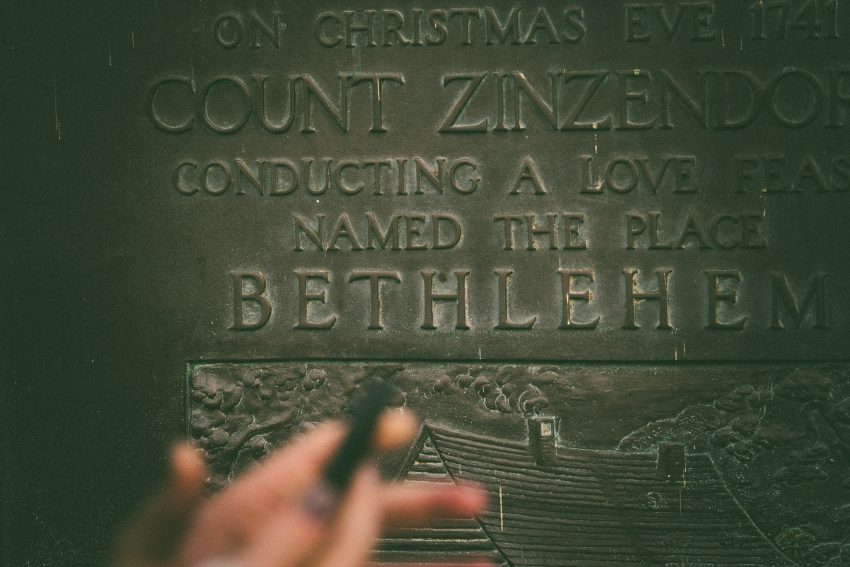One of the most commonly asked questions on the campus of Pittsburgh Theological Seminary is What denomination are you? Though the most common response is Presbyterian, it is equally as common to receive answers such as Baptist, Episcopal, Catholic, Methodist or any of the other one on the spectrum that make up the student body’s denominational kaleidoscope; all of which I had some relative familiarity with. That is, until one day a member of the faculty, Dr. Heather Vacek, mentioned being a member of the Moravian Church.
Moravian? I thought. What is a Moravian?
Now many of you may also be wondering that as well, which is why I decided to satisfy both yours and my curiosity by researching with the help of the afore mentioned Dr. Heather Vacek.
The Moravian Church is one of the oldest protestant denominations still active today. Its origins are actually found in pre-reformation. Though it was officially founded in the year of 1457 under the name of Unitas Fratrum (which is Latin for Unity of the Brethren) in Bohemia or what is modern day Czech Republic, before that can be found the influence of one John Hus. John Hus (1369 – 1415), a native of Bohemia, attained the position of both priest and professor and spent a good portion of his prolific career defending the ideals of John Wycliffe (1324 – 1384), an English born priest and professor who ascribed to the stance that the church should retain a lesser role, in specific to the vast wealth it had accumulated and its habit of dabbling with current political affairs. Hus sought church reform that would restore Scripture to being the highest authority and used the language of the people in service instead of Latin, for which he was burned at the stake in the end.
But that was not to be the end. Under the ideas circulated by John Hus, a man by the name of Gregory with a group of friends sought a way to live in community that was grounded in the Scripture, and a few years after the construction of the group began referring to themselves as Unitas Fratrum. However, the establishment of a group outside the church was forbidden and they had begun to be persecuted, yet the growing popularity continued, helping in keeping the worst at bay. Eventually they became an official and independent church in 1467 with their own line of ministry and ordained ministers.
Unitas Fratrum continued to grow and seek lives of living in Christian community, and even maintained contact with Luther during the Reformation. But they too fell victim to the persecution that followed for all Protestant churches and were forced to maintain their worship underground or on the run for the years to come. That is until the year 1722 when in Germany there came about a revival through the patronage of Count Nicholas Ludwig von Zinzendorf who permitted a group of Unitas Fratrum from Moravia (which is how the name Moravian became attributed to the church) to be established on his land and was active in leadership of the church. Slowly Moravianism crept out into the world through the influence of both their high activity in mission work in the community and abroad, and in their general expansion. Within five years of that renewal, Moravian missionaries set out to many parts of the world including the American colonies.
There is much more that goes into the intricate history of the Moravian Church but there are key attributes that are foundational to their identity. One is the emphasis on peace, reconciliation and care for others in need. Another is living a life of faith stressed in active love as a service to the world. And a third is intentional retention of a Christian community with moderation and simplicity being major factors of its development. These are as essential to Moravians as the doctrine is, and they place high value on their relationships with not only Christians of other Moravian provinces but also with Christians of other denominations, as evident through the Covenant Partnership the provinces of the Moravian Church in North America has with PC(USA).
So, what does this have to do with anything? Though my time here at PTS has been limited, I immensely enjoy having all these different flavors of traditions and denominations so we can learn from each other while looking one another in the eye. And this promotes greater understanding and propels us further in the establishment of knowing what the whole Body of Christ looks like through its reflection in the student body. The greatest things we have to learn is from each other.
By Rebecca Dix, MDiv student, and Dr. Heather Vacek
Author’s Note: All information within this blog is derived from two sources, so any further study can be pursued through these veins of knowledge.
Weinlick, John R. and Albert H. Frank. The Moravian Church through the Ages: The Story of a Worldwide, Pre-Reformation Protestant Church. Moravian Church in America: Bethlehem, PA, 1966.
The Moravian Seminary. http://www.moravianseminary.edu/moravian-studies/about-the-moravians.html

